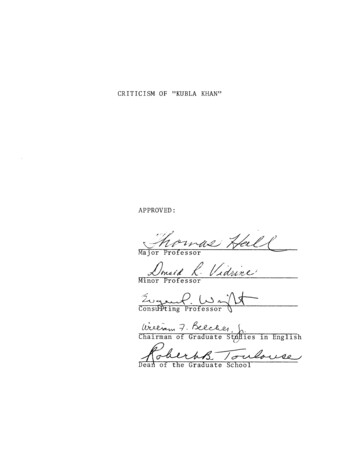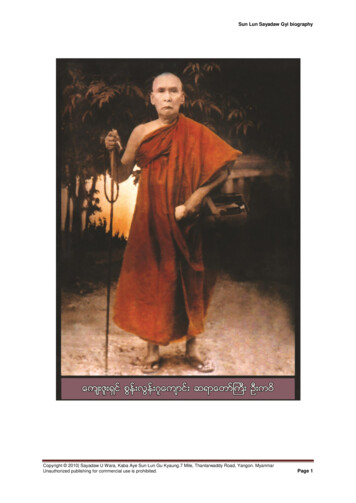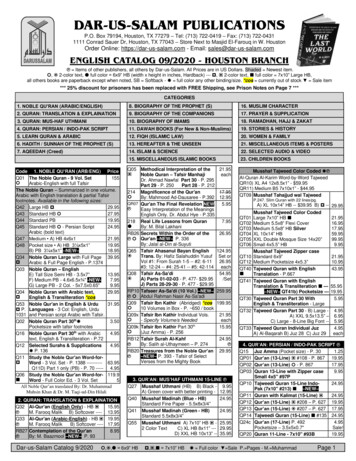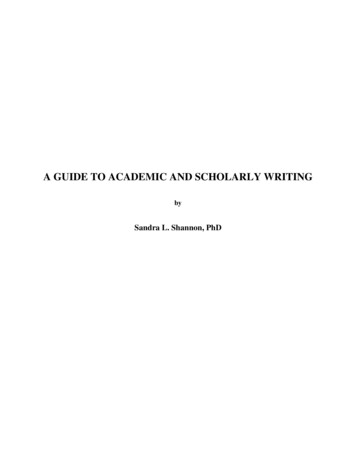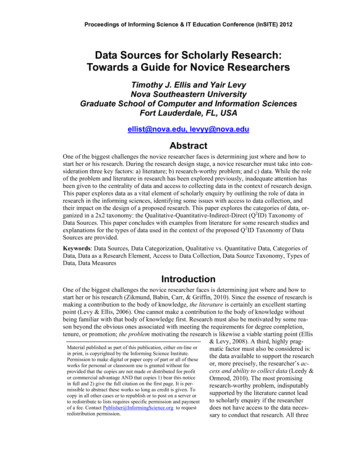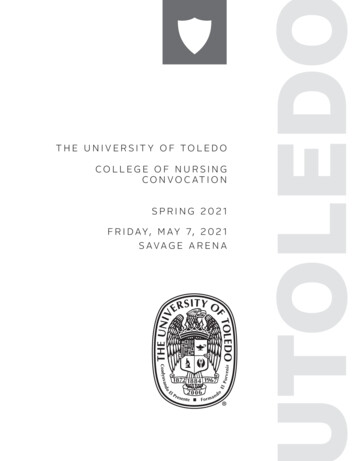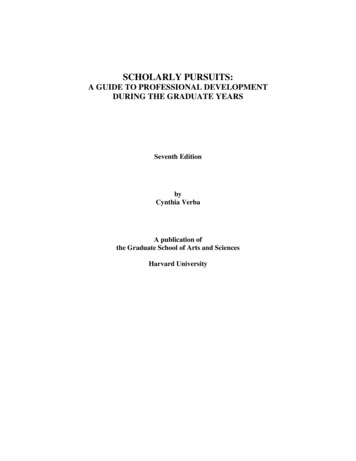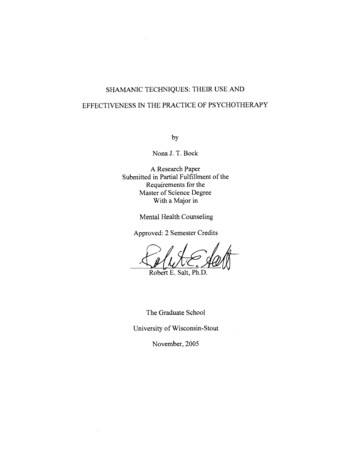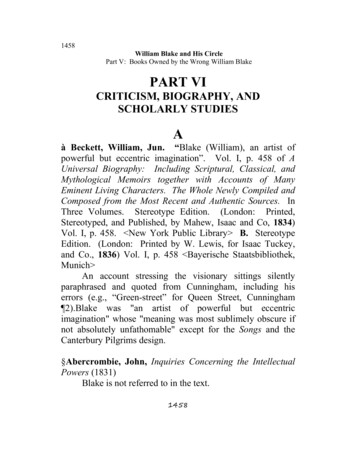
Transcription
1458William Blake and His CirclePart V: Books Owned by the Wrong William BlakePART VICRITICISM, BIOGRAPHY, ANDSCHOLARLY STUDIESAà Beckett, William, Jun. “Blake (William), an artist ofpowerful but eccentric imagination”. Vol. I, p. 458 of AUniversal Biography: Including Scriptural, Classical, andMythological Memoirs together with Accounts of ManyEminent Living Characters. The Whole Newly Compiled andComposed from the Most Recent and Authentic Sources. InThree Volumes. Stereotype Edition. (London: Printed,Stereotyped, and Published, by Mahew, Isaac and Co, 1834)Vol. I, p. 458. New York Public Library B. StereotypeEdition. (London: Printed by W. Lewis, for Isaac Tuckey,and Co., 1836) Vol. I, p. 458 Bayerische Staatsbibliothek,Munich An account stressing the visionary sittings silentlyparaphrased and quoted from Cunningham, including hiserrors (e.g., “Green-street” for Queen Street, Cunningham¶2).Blake was "an artist of powerful but eccentricimagination" whose "meaning was most sublimely obscure ifnot absolutely unfathomable" except for the Songs and theCanterbury Pilgrims design.§Abercrombie, John, Inquiries Concerning the IntellectualPowers (1831)Blake is not referred to in the text.1458
William Blake and His CirclePart VI: Biography and CriticismREVIEWAnon., “Abercrombie’s Inquiries”, Edinburgh EveningPost, and Scottish Literary Gazette, 7 May 1831,pp. 150-51 (reprinted in David Groves, “Blake andthe Edinburgh Evening Post”, Blake, XXVI, 2[Fall 1992], 51) (draws a parallel betweenAbercrombie’s patient who saw “visualphantasm[s]” and “Blake, the eminent artist, whohad such visions” according to Cunningham) BBS339 §Abraham, Gerald. “The Genius of William Blake.” RadioTimes, 10 December 1937.§Abrahams, Cecil. "William Blake and the RomanticPerception of Romanticism." In The Question of Humanism:Challenges and Possibilities. Ed. David Goicoechea, John C.Luik, and Tim Madigan. (Buffalo: Prometheus Books, 1991)§Abramovitch, N.Y."Estetism i erotika . Bleik[Aestheticism and Eurotics . Blake]." Obrazovanye, V(1906), Section 2, pp. 21-51. In Russian§Ackland, Michael. “Breeding ‘Reptiles of the Mind’:Blake’s Dialectics of Vision and [Christine] Stead’s Critiqueof Pollitry in The Man Who Loved Children.” Studies in theNovel, XXXVIII (2006), 234-49.Ackroyd, Peter, Blake (London: Sinclair-Stevenson, 1995)8o, 399 pp., 136 reproductions; ISBN: 1856192784 B.(London: Minerva, 1996) 8o, xv, 442 pp., 64 reproductions;1459
1460William Blake and His CirclePart VI: Biography and CriticismISBN: 0749391766 C. (N.Y.: Ballantine Books, July 1997)8o, 398 pp., 121 reproductions; ISBN: 345376110 D. WilliamBlake, Dichter, Maler, Visionär. Tr. Thomas Eichorn.(München:Albrecht Knaus, 2001)8o, 475 pp., 58reproductions; ISBN: 3813501027 In German§ E. Tr. EwaKraskowska. (Poznan: Zysk i S-Ka Wydawnictwo, 2001) InPolish F. *Blake den [The Life of Blake] Tr. Masayuki Ikeda,Hachisu Izumi, Shigeru Ito, and Masayuki Takakura. (Tokyo:Misuzu Shobo, 2002) 468 pp., 105 reproductions; ISBN:462047187 In Japanese G. §William Blake: Dichter, Maler,Visionär. Tr. Thomas Eichhorn. (München: Albrecht Knaus,2004) In German H. §(London: The Folio Society, 2008) 4o,xv, 455 pp.; no ISBNThe 1996 paperback edition is reset withoutacknowledged change on paper about 1" x 1" smaller; all thereproductions on the 1995 text-pages are omitted in the 1996edition, and the other reproductions are reduced in size.The 1997 hard cover edition seems to be reproducedfrom the 1995 edition.“The text of this [Folio Society] edition follows that ofthe first edition [1995], with minor emendations”, but the 52colour illustrations are revised.An elaborately detailed biography of Blake as a"Cockney visionary", an "urban genius" (pp. 92, 229), with agood deal of analysis of Blake's words (conventional) anddesigns (often ambitious and interesting).An extract appears in his "The Doors of Perception",Independent on Sunday, 27 August 1995, and an excerpt from1460
William Blake and His CirclePart VI: Criticism1461Chapter 5 was reprinted in Lonsdale: The InternationalQuarterly of The Romantic Six, II, 1 (January 1996), 12-13.Hear also §Peter Ackroyd, Blake (Newport Beach[California]: Books on Tape, 1997), 13 sound cassettes (1½hours each) read by Ian Whitcomb.For his account of writing the book, see Journal of theBlake Society (1996), 3-4.The German edition apparently contains no new matter.2008 The text of the Folio Society edition is that of thefirst edition "with minor emendations" (p. iv).REVIEWS &c*Jonathan Bate, "William Blake in the new Jerusalem:Jonathan Bate admires Peter Ackroyd's biographyof the great London visionary", Sunday Telegraph[London], 3 September 1995 ("a biography ofBlake which is lucid and measured, but alsointuitive and empathetic. The scholarship isimpeccable, yet at the same time the novelist hasgot under his man's skin")§Observer Review [London],3 September 1995, p. 14§New Statesman and Society [Middlesex, N.J.], VIII (8September 1995), 36*Grey Gowrie, "Heaven and hell and infinite London:Grey Gowrie acclaims the sublime spellbindingbiography of a poet who continues to be an icon",Daily Telegraph [London], 9 September 1995, p.A7 ("a masterpiece of a biography")*John Carey, "Heaven on earth: John Cary is inspiredby a sensuous and glowing portrayal of thecelestial world of William Blake", Sunday Times[London], 10 September 1995 ("Ackroyd's1461
1462William Blake and His CirclePart VI: Biography and Criticismbiography will send many readers back to thepoems enriched and newly attentive")§Times [London], 11 September 1995, p. 17*[John Bayley], "The Lambeth seer reclaimed for ourtime: John Bayley pays tribute to a new life ofBlake, a very English poet and the sanest ofrevolutionaries", Times [London], 14 September1995, p. 38. B. Reprinted as "They Said It",Lonsdale: The International Quarterly of TheRomantic Six, II, 1 (January 1996), 5 (a "grippinglyperceptive study")§Spectator, CCLXXV (23September 1995), 36 *Malcolm Bull, "Liberty Boy-Genius: The politics,religion and sexuality of a counter-Enlightenmenteccentric", Times Literary Supplement, 20 October1995, pp. 3-4 ("This is, without doubt, the bestavailable biography of Blake", but it reduces "hisimaginative world to the wholly uninformativecategory of the 'Cockney visionary'" and omitsserious consideration of his "politics, religion andsexuality")Leonee Ormond, Country Life (26 October 1995), 74("a remarkably human biography")§John Bemrose, "Burning bright", Macleans, CVIII (6November 1995), 80. B. Reprinted in Lonsdale:The International Quarterly of The Romantic Six,II, 1 (January 1996), 7-8 ("Ackroyd has given theartist a more palpable, detailed presence than hehas enjoyed at any time since his death")1462
William Blake and His CirclePart VI: Criticism1463Anon., "Anti-Enlightenment visionary", EconomistReview, 11 November 1995, pp. 4-5 (Ackroyd"sympathises deeply with Blake's struggles" andtakes Blake's "visions as seriously and soberly ashe did", but he is "badly served by the book'sdesigner" and editor for tolerating muddy platesand prolix "displays of erudition")*Lars Bergquist, "Med visionen för en bättre värld[With a Vision of a Better World]", SvenskaDagbladet, 21 November 1995, in Swedish(Ackroyd's biography is a virtuoso performancewhich yet has not gone sufficiently intoSwedenborg's thought)§Spectator, CCLXXV (25 November 1995), 48§Observer [London], 26 November 1995, p. 7*Andrew Motion, "A passionate dissent", GuardianWeekly [London], 17 December 1995, p. 28 ("itstreatment of this central issue -- the business of themadness--is disappointingly under-developed")*Alberto Manguel, "Genius of Blake revealed:Ackroyd makes it clear we owe the poet a greatmany revelations about our senses", Globe andMail, [Toronto] 13 January 1996, p. C20 (withanother)Iain Sinclair, "Customising Biography", London Reviewof Books, XVIII, 4(22 February 1996), 16-19(with 5 others) (an enormous, and enormously selfindulgent, meander through what he thinks g incidentally that Ackroyd's "Blake isdecently crafted fiction overwhelmed by an excess1463
1464William Blake and His CirclePart VI: Biography and Criticismof tyrannical facts" "with perhaps a little too muchfondness for local colour" [p. 18])§Publishers Weekly, CCXLIII (26 February 1996), 90(combines "meticulous scholarship with uncannypsychological insight")§Library Journal [Merion, Ohio], CXXI (1 April 1996),80 §New York Times Book Review, CI (14 April 1996), 5("a brilliant guide and interpreter")§Robert M. Adams, Wall Street Journal [Mid-WestEdition], LXXVII (9 April 1996), A17 ("Superb .makes Blake live")Penelope Fitzgerald, "Innocence and Experience", NewYork Times, 14 April 1996 (Ackroyd is "readerfriendly . a brilliant guide and interpreter")Paul Cantor, "William Blake, Capitalist", WeeklyStandard, 22 April 1996, pp. 29-32 (Ackroyd's"new biography of Blake" stresses insufficientlythat Blake shows "the dogged spirit of the Englishsmall businessman" but that Blake "constantlymisreads the market; he didn't ignore or abjure it"[pp. 31, 30])George Gurley (Kansas City Star), "Illuminating thevisions of William Blake", Chicago Tribune, 23April 1996, Section 2, p. 3 (Ackroyd's "stylishwriting [is] lyrical and illuminating without beingintrusive"--and Mr Gurley has discovered thatBlake "could swear in nine languages")§Colin Steel, Australian Book Collector (April 1996)(with another)1464
William Blake and His CirclePart VI: Criticism1465Anon., Lonsdale: The International Quarterly of TheRomantic Six, II, ii (April 1996), 11-[15] (reviewof Chapters 8-14) ("That which made Blake a trulygifted man was his abilities and talents as atradesman" [p. 12])§Book World [Washington Post], XXVI (12 May 1996),l §John Banville, Los Angeles Times Book Review, 19May 1996, p. 4Michael Dirda, International Herald Tribune, 21 May1996, p. 10 ("Peter Ackroyd makes Blake live forthe modern reader")*Kennedy Fraser, "Piper Pipe that Song Again: PeterAckroyd finds a William Blake for our time", NewYorker, 27 May 1996, pp. 126-31 ("This is a bookwith bounce and push" about a man whose "workjust glows, somehow")§Bookwatch [Oregon, Wisconsin], XVII (May 1996), 8Vincent Stanley, “Dirty Blake”, Independent [SantaBarbara, California], 3 July 1996§World & I [Washington, D.C.], XI (August 1996),260 §Wilson Quarterly [Palm Coast, Florida], XX (Summer1996), 96 §Publishers Weekly, CCXLIII (4 November 1996), 42§New York Times Book Review, CI (8 December 1996),85§Antioch Review, LIV (Fall 1996), 487 Tim Heath, Journal of the Blake Society (1996), pp. 7779 (Ackroyd "builds up a life, slowly, with careand with detail")1465
1466William Blake and His CirclePart VI: Biography and Criticism*Dharmachari Ananda, "A Grain of Sand inLambeth", Urthona, No. 5 [1996], 43-46 (it is "arich and closely observed biography" with a sharpfocus on "tiny but telling detail", but "Ackroyd hasa tendency to be dogmatic", and "the whole manmanages to elude us")Morton Paley, Blake, XXX, 2 (1996), 58-61 (because"questionable statements pervade Ackroyd'sBlake", the book "is a disappointment" [pp. 59,60])Peter Ackroyd, "The Writing of Blake", Journal of theBlake Society at St James, No. 2 (1996), 3-4 (ageneral account of the writing of his biography)§Booklist [Aurora, Illinois], XCII (1996), 1338, 1349("intelligently researched and highly sensitive")§Kirkus Reviews [N.Y.], LXIV (1996), 267 ("sosensitive to its subject, it seems to have conjured[Blake] from the beyond").§Booklist, XCIII (January 1997), 359§Choice, XXXIV (May 1997), 1493John V. Fleming, Sewanee Review, CV (1997), xxxviii,xl-xli (with another) (an "excellent" example of"haute vulgarisation")Michael Phillips, Burlington Magazine, CXXXIX(1997), 338-39 (with 8 others) (Ackroyd andGilchrist "marvellously recreate the atmosphere ofeach location" where Blake lived in London)§Helen Pike Bauer, Cross Currents, XLVII (1997),114-171466
William Blake and His CirclePart VI: Criticism1467Aileen Ward, "Scrutinizing Blake", Partizan Review,LXIV (1997), 473-81 ("the reader looking for anew understanding of Blake's work, or of . [his]imagination . may well be disappointed", but,despite inaccuracies and "slipshod" documentation,Ackroyd's "lively and ambitious portrait shouldwin new admiration with many readers" [pp. 474,481])§Aston Nichols in Southern Humanities Review, XXXI(1997), 284-89David Worrall, Year's Work in English Studies, LXXVIfor 1995 (1998), 398 ("a careful assemblage of thenarrative from his highly eclectic sources")§Alfred Nemeczek, Art: Das Kunstmagazin (January2001), 114, in German (review of the Germanedition)§Baltimore Sun ("Fascinating") @§Chicago Tribune ("lyrical and illuminating") @§Daily News [N.Y.?] ("always absorbing . admirable")@§Miami Herald ("The events of Blake's life are radiantlyresurrected here") @§St. Louis Post-Dispatch ("Splendid . Peter Ackroydhumanizes Blake") @§San Francisco Chronicle ("Ackroyd . plays with theoddities of time and reality") @§Sunday Oregonian ("Refreshing . stylish narrative")@§Virginian-Pilot ("Readers almost feel what Blake feltwhen he saw the visions") @1467
1468William Blake and His CirclePart VI: Biography and Criticism@ quoted from the puffs on the Ballantineedition§[Ackroyd, Peter] Akroĭd, Piter, tr. Svetlana Likhacheva."Chelovek po imeni Vĭl'liam Bleik." Inostrannaya Literatura,III (2011), no pagination In Russian*Ackroyd, Peter. "Cockney Visionaries." Independent[London] 18 December 1993, p. 27."I want . to describe those London luminaries andCockneys [chiefly "that Cockney visionary William Blake",Dickens and J.M.W. Turner] who in their art have expressedthe true nature and spirit of" London. "Cockney" here appearsto mean someone who epitomizes London.*Ackroyd, Peter. "The Doors of Perception: An extractfrom the brilliant new biography of poet, artist and visionaryWilliam Blake." Independent on Sunday [London], 27 August1995, 24-25, 27.When he was young, "Blake and all his friends werecommitted political radicals", and "In fact he had workedwithin a radical milieu all his life. His parents were of old citystock characterised by its republican attitudes ."§*Ackroyd, Peter. “The London that became Jerusalem.”Times [London], 3 March 2007, p. 6.About Blake’s 250th anniversary.*Ackroyd, Peter. “Oh come, all ye faithful: Inspired byMilton’s formidable personal piety, William Blake sought to1468
William Blake and His CirclePart VI: Criticism1469create his own system in words and images to rouse the nationfrom spiritual slumber.” Guardian [London], 26 April 2003,online.*Ackroyd, Peter. "To the rescue of a cockney prophet: PeterAckroyd tells Giles Coren why William Blake is unjustlyneglected." Times [London], 11 September 1995, p. 17."Blake is a much better poet than people think"; "Therehas never been a substantial biography of Blake"; "in fictionyou have to tell the truth. In biography you can make thingsup."§Ackroyd, Peter. "William Blake, a Spirited Radical." In hisThe Collection. Ed. Thomas Wright. (London: Chatto andWindus, 2001)From his reviews and articles in the Spectator.Adachi, Naoko. “Kyusai no Vision no Tankyu: Atarashii Hitoyo Mezame yo niokeru Blake Inyo [An Exploration of Visionof Salvation: The Quotations from Blake in Rouse Up OYoung Men of the New Age!]”. Kirisuto Kyo Bungei[Christian Literature], No. 31 (2015), 85-102. In Japanese.Blake and the novel by Kenzaburo Oe.Adams, Hazard, Antithetical Essays in Literary Criticismand Liberal Education (1990) BBS Chapter 4, “Revisiting Reynolds’s Discourses andBlake’s Annotations” (pp. 184-98), reprinted from Blake inhis Time, ed. R.N. Essick and Donald Pearce (1978) (pp. 12844), was revised and reprinted in his Blake’s Margins: AnInterpretive Study of the Annotations(2009), 105-38.1469
1470William Blake and His CirclePart VI: Biography and CriticismAdams, Hazard. "Blake and Joyce." James Joyce Quarterly,XXXV-XXXVI [a double issue] (1998), 683-93.About "the experimental shapes of Jerusalem andFinnegans Wake" (p. 683).Adams, Hazard. Blake and Yeats: The Contrary Vision.(Ithaca [N.Y.]: Cornell University Press, 1955) CornellStudies in English Volume XL B. (N.Y., 1968) BB C.§(Temecula [California]: Textbook Publishers, 2003) xvii,328 pp.; ISBN: 0758144725REVIEWS§Anon., Dublin Magazine, XXXI, 3 (July-September1956), 52-53§Anon., United States Quarterly Book Review, XII(1956), 170-71§Anon., Yale Review, XLV (1956), vi-viii§Calvin D. Linton, American Scholar, XXXV (1956),378§William Van O’Connor, College English, XVIII(1956), 127D.V. E[rdman], Philological Quarterly, XXXV (1956),107§P.F. Fisher, Queen’s Quarterly, LXIV (1957), 155-57§Kenneth O. Hanson, Journal of Aesthetics and ArtCriticism, XV (1957), 372§T.R. Henn, Modern Language Review, LII (1957),263-65§V.G. Kiernan, Science and Society, XXI (1957), 185871470
William Blake and His CirclePart VI: Criticism1471§Thomas Parkinson, Modern Philology, LIV (1957),281-84*Adams, Hazard. Blake’s Margins: An Interpretive Study ofthe Annotations.(Jefferson [North Carolina] and London:McFarland and Company, 2009)4o, 204 pp.; ISBN:9780786445363It consists of Chapters on Blake’s annotations to (1)Lavater, Aphorisms (pp. 7-27), (2) Swedenborg, Heaven andHell, Divine Love, and Divine Providence (pp. 28-60), (3)Watson, Apology (pp. 61-80), (4) Bacon, Essays (pp. 81-96),(5) Dante, Inferno, tr. Boyd (pp. 97-108), (6) Reynolds,Discourses (pp. 109-38), (7) Spurzheim, Insanity (pp. 13949), (8) Berkeley, Siris (pp. 150-59), (9) Wordsworth, Poemsand Preface to The Excursion (pp. 160-76), (10) Thornton,Lord’s Prayer (pp. 177-92), plus “Addendum” (pp. 193-94)and (12) “A Note on Blake’s Reading” (pp. 195-97).Earlier versions of Chapter 6 appeared in “RevisitingReynold[s]’s Discourses and Blake’s Annotations”, pp. 12844 of Blake in His Time, ed. R.N. Essick and Donald Pearce(1978) BBS and in his Antithetical Essays in LiteraryCriticism and Liberal Education (1990), 184-98 BBS .REVIEWSJason Whittaker, Zoamorphis: The Blake 2.0 Blog online [16 February 2010] (“there is nothing that isspecifically new or innovative”, but it is useful onthe context)Shirley Dent, Times Literary Supplement, 2 July 2010,pp. 26-27 (with another) (it is his “close andunswerving attention to what Blake has to say” thatmakes the book “so rewarding”)1471
1472William Blake and His CirclePart VI: Biography and CriticismMorton D. Paley, Review 19 [online] (22 May 2010),12 pp. (“Adams makes Blake’s thought accessiblein non-'Blakean’ terms”)Jason Whittaker, Year's Work in English Studies, XC,1 (January 2011), 651-52*Alexander S. Gourlay, Blake, XLV, 2 (Fall 2011)Adams, Hazard, ed., Critical Essays on William Blake (1991) BBS REVIEWSJeffrey D. Parker, Blake, XXVI, 2 (Fall 1992), 60-61(mostly a summary of "Adams' strategy" inchoosing authors, which "is successful" [p. 61])D.W. Dörrbecker, Blake, XXVI, 3 (Winter 1992-93),86 (in “William Blake and His Circle”)Peter Kitson, Year's Work in English Studies, LXXII(1993), 280-81) ("useful")Brian Wilkie, Eighteenth Century . Bibliography, NSXVI for 1991 (1998), 239-30Adams, Hazard."Jerusalem's Didactic and MimeticNarrative Experiment: In Happy Memory of Northrop Frye."Studies in Romanticism, XXXII (1993), 627-54."In Jerusalem Blake sets contraries to the task ofbuilding an order in disorder and disorder in order at the sametime – and in the same place"--"an introduction to a reading"(p. 627), with a survey of Jerusalem criticism (pp. 651-54).*Adams, Hazard. Thinking through Blake. (Jefferson, NorthCarolina: McFarland and Company, 2014. 4o, vii, 195 pp.;1472
William Blake and His CirclePart VI: Criticism1473ISBN: 9780786479580It consists of“Blake, Jerusalem, and Symbolic Form (1975).” Pp. 17-39.“Contemporary Ideas of Literature: Terrible Beauty or RoughBeast (1977).” Pp. 40-64.“Essay on Frye (1991).” Pp. 65-69.“Reynolds, Vico, Blackwell, Blake: The Fate of Allegory(1993).” Pp. 70-85. [From Enlightening Allegory, ed.Kevin Cope (1993)]“The World View of Blake in Relation to Cultural Policy(1993).” Pp. 86-97. [From Cultural Policy, Past,Present and Future, ed. Harold Coward (1990), CriticalEssays on William Blake, ed. Hazard Adams (1991), andReflections on Cultural Policy, ed. Evan Alderson et al(1993)]“Conference 2: Chinese and Japanese-American LiteraryRelations (1994).” Pp. 98-107.“Is (Was) There No Tradition of Defense of Poetry in ChineseCulture? Why Has There Had to Be One in the West?(1994).” Pp. 108-21.“Four Problems (Among Many) For Humanistic Thought(1995).” Pp. 122-26.“’Literature’ and the Visionary Tradition (1995).” Pp. 12730.“’Literature’ into ‘Ecriture’? (1995).” Pp. 131-33.“’An Antithetical Turn’ (1996).” Pp. 134-47.“Ekphrasis Revisited, or Antithetically Reconstructed (2000).”Pp. 148-60.“Quest and Cycle (2005).” Pp. 161-64.“Origin(ality) (2007).” Pp. 165-70.“The Marriage of Imagination and Intellect (2013).” Pp. 171-1473
1474William Blake and His CirclePart VI: Biography and Criticism82.Chapter Notes, pp. 183-90.Most of the essays are not explicitly related to Blake.§*Adams, Hazard. William Blake on His Poetry andPainting: A Study of A DESCRIPTIVE CATALOGUE, Other ProseWritings, and JERUSALEM.(Jefferson [North Carolina]:McFarland and Company, 2010 [copyright 2011]) 199 pp.ISBN: 9780786445866REVIEWR. Paul Yoder, Blake, XLVI, 2 (Fall 2012) (There are"gems scattered throughout the book", but thewriting is "a bit dry")Adams, Hazard. “Reading Blake’s Lyrics: ‘The Tyger’.”Texas Studies in Literature and Language, II (1960), 18-37. BB B. Reprinted in Discussions of William Blake. Ed.John E. Grant. (Boston, 1961). BB C. §Reprinted inEnglische Lyrik von Shakespeare bis Dylan Thomas. Ed.Willi Ersgräber. (Darmstadt, 1969) Ars interpretandi, Vol. I.In German BBS Pp. 53-54 of 1961 are reprinted as “On Blake’s System”in pp. 20-22 of William Blake: Comprehensive Research andStudy Guide, ed. Harold Bloom (2003).Adams, Hazard. "Reynolds, Vico, [Thomas] Blackwell,Blake: The Fate of Allegory." Pp. 3-20 of EnlightenmentAllegory: Theory, Practice, and Context of Allegory in the1474
William Blake and His CirclePart VI: Criticism1475Late Seventeenth and Eighteenth Centuries. Ed. Kevin L.Cope. (N.Y.: AMS, 1993)*Adams, Hazard. William Blake: A Reading of the ShorterPoems. (Seattle, 1963) BB B. §(Folcroft [Pennsylvania],1980) C. §(Philadelphia, 1983) BBS Chapter VI (“‘The Crystal Cabinet’ and ‘The GoldenNet’”) was reprinted in Blake: A Collection of Critical Essays,ed. Northrop Frye (1965) BB ; pp. 252-55 as “Two Nurse’sSongs” on pp. 100-4 of Twentieth Century Interpretations ofSongs of Innocence and of Experience: A Collection ofCritical Essays, ed. Morton D. Paley (1969) BB ; pp. 58-74in William Blake: The Tyger, ed. Winston Weathers (1969) BB ; and pp. 80-83 from Frye (1965) as “On Innocence andImages” on pp. 94-97 of William Blake: ComprehensiveResearch and Study Guide, ed. Harold Bloom (2003).REVIEWSSven Armens, Philological Quarterly, XLIII, 3 (July1963), 341-44John E. Grant, “Blake Original and New”, ModernLanguage Quarterly, XXV, 3 (September 1964),356-64 (with 2 others)§Robert F. Gleckner, Journal of English and GermanicPhilology, LXIII, 4 (October 1964), 802-5 (withothers)§Marius Bewley, Hudson Review, XVII, 2 (Summer1964), 278-85 (with others)§Remi G. Dubuque, Thought, XXXIX (1964), 618-19D.V. E[rdman],Philological Quarterly, XLIII (1964),447-48§Hugh J. Luke, College English, XXV (1964), 635-361475
1476William Blake and His CirclePart VI: Biography and Criticism§E.J. Rose, Dalhousie Review, XLIV (1964), 351-53Michael J. Tolley, English Language Notes, II (1964),140-44§F.W. Bateson, Review of English Studies, NS XVI, 62(January 1965), 226-27§T.R. Henn, Modern Language Review, LX, 1(January 1965), 97-99§Donald Weeks, Journal of Aesthetics and ArtCriticism, XXIII, 3 (Spring 1965), 394-95§Martin K. Nurmi, Criticism, VII (1965), 110-11§Henri Lemaitre, “A propos de William Blake”, Etudesanglaises, XX (July-September 1967), 289-96, inFrench (with 4 others)§Erich Zauner, Erasmus–speculum scientiarum, XXII(1970), cols. 455-56§Adams, Hazard. "William Blake: Imagination, Vision,Inspiration, Intellect." In Inventions of the Imagination:Romanticism and Beyond. Ed. Richard T. Gray (Seattle:University of Washington Press, 2011)§Adams, Hazard. “The Worldview of William Blake inRelation to Cultural Policy.” Critical Essays on WilliamBlake, ed. Hazard Adams (Boston, 1991) BBS B.Reprinted in Reflections on Cultural Policy, Past, Present,and Future. Ed. Evan Alderson, Robin Blazer, Harold G.Coward, et al.(Waterloo, Ontario: Wilfred LaurierUniversity Press for Calgary Institute for the Humanities,1993)1476
William Blake and His CirclePart VI: Criticism1477§Adams, Will W. “Love, Open Awareness, and Authenticity:A Conversation with William Blake and D.W. Winnicott.”Journal of Humanistic Psychology, XLVI, 1 (2006), 9-25.“Blake’s work and life are read in light of Winnicott’stheory of developmental psychotherapy”.§Adams, Will W. “William Blake’s Integral Psychology:Reading Blake and Ken Wilber Together.” Journal ofTranspersonal Psychology, XXXVIII, 1 (2006), 55-72.*Adamson, Joseph. Northrop Frye: A Visionary Life.(Toronto: ECW Press, 1993) 8o; ISBN: 1550221841One of the nine sections (pp. 40-45) of this 93-pagecritical biography is on Frye's Fearful Symmetry.§Adda, Maggy. "William Blake (1757-1827). Le graveurinspiré." Art et métiers du livre, No. 224 (mai-juin 2001), 3637. In FrenchAdlard, John, The Sports of Cruelty: Fairies, Folk-Songs,Charms and Other Country Matters in the Work of WilliamBlake (1972) BB #A792 REVIEWSKatharine M. Briggs, Blake Newsletter, VII, 1(Summer 1973), 22-23§T.R. Henn, Modern Language Review, LXIX (April1974), 379-80Irene H. Chayes, Studies in Romanticism, XIII, 2(Spring 1974), 155-64 (with 5 others) ("less afinished study than a prematurely published draft")1477
1478William Blake and His CirclePart VI: Biography and Criticism§F.W. Bateson, Notes and Queries, NS XXII (1975),83-84 (with 2 others)Mary Lynn Johnson, Blake Studies, VII, 1 (1975), 18688§Afanas'eva, K. "Uil'yam Bleik. Pesn' svobody: Prolog, iliosnavanie. 'Tiriel' i 'Kniga Tel': mystarstva zemno dushi[William Blake. Song of Freedom. Prologue, or base."Tiriel" and "The Book of Thel": ordeals of the earthly soul']Pp. 189-223 of Temnitsa i svoboda v khudozhestvennom mireromantizma [Dungeon and Freedom in the Art World ofRomanticism]. (Moscow, 2002)Aghe, Marisa. “UCR professor [R.N. Essick], colleaguesbreak new ground: William Blake: Their Web-site devoted tothe poet is the first electronic effort to win a key honor.”Press-Enterprise, 1 January 2004, p. B10.*Ahearn, Edward J. "An Anatomy of the Visionary:Blake's Marriage of Heaven and Hell." Chapter I (pp. 13-33,175-178) of his Visionary Fictions: Apocalyptic Writing fromBlake to the Modern Age. (New Haven and London: YaleUniversity Press, 1996) Also passim.REVIEW§Keri Davies, British Journal for Eighteenth CenturyStudies, XXII, 2 (1999), 224-26 (with 4 others)§Ahlstrom, Chrispin."Poet-Profet ochGöteborgs-Posten, 27 April 1974. In Swedish1478konstnar."
William Blake and His CirclePart VI: Criticism1479Ainger, Alfred. "Mr. Churton Collins and William Blake."Times Literary Supplement, 6 June 1902, p. 164.Charles Lamb admired "The Tyger".For ramifications of this TLS teapot tempest, see Collins,"The 'Quarterly Review' and Mr. Stephen Phillips's Critics", 9May 1902; Anon., "Mr. Churton Collins and the 'QuarterlyReview'", 16 May 1902; "The 'Quarterly Review' and Mr.Andrew Lang", 23 May 1902; W.B. Yeats and J. ChurtonCollins, "Mr. Churton Collins on Blake", 30 May, 13 June1902; B.C. Beeching, "The Poetry of Blake", 20 June 1902.§Aird, Thomas. The Old Batchelor in the Old ScottishVillage. (Edinburgh: Myles Campbell; London: Simpson,Marshall, and Co, 1845) Pp. 36-37. Bodley Without the help of any suggestion whatever fromany external object on which he might be gazing,that sweet, strange enthusiast, the painter Blake,had the power, sometimes voluntary and sometimesinvoluntary, of calling up a face, and seeing withhis bodily eyes projected in palpable semblance onthe air or the wall before him .§Aitken, James. "William Blake." In his English Letters ofthe XVIII Century. (Harmondsworth [Middlesex]: PenguinBooks [1946]) Pelican Books [A163]Aitken, Kelley. “Wonder; No Wonder: William Blake’sIllustrations to the Book of Job.” Queen’s Quarterly, CXIV, 4(2007), 571-75.1479
1480William Blake and His CirclePart VI: Biography and Criticism*Alberga, Dalya. "Export ban on Blake's heavenly vision."Times [London], 24 October 2000.Announcement of "a three-month ban to enable a Britishinstitution to raise about 650,000 to buy God Blessing theSeventh Day". (By the summer of 2001 it was in the UnitedStates, according to R.N. Essick, "Blake in the Marketplace,2001", Blake, XXXV [2002], 111.)§Albuquerque, Sebastião da Cunha. "Pantheism in Poetry:William Blake and William Wordsworth." Revista Seringalde Idéias, I, 1 (2008).§Aldington, Richard. “Everyman’s Poets.” Everyman, 15April 1933.Aldrich, Richard. "Mrs. F.S. Coolidge; Children Excel in aCharming Fantasy, Arranged from Poems by William Blake,on South Mountain [Pittsfield, Massachusetts]."New YorkTimes, 13 September 1926, p. 18Alexander, Bryan Nemo, "Dialectical Nightmares: Thehistoricity of the Romantic-era doppelganger in the works ofGodwin, Hogg, Blake, Burney, and the Shelleys." DAI, LVIII(1998), 3927A. Michigan Ph.D., 1997, 147 pp."Blake (Jerusalem) and Shelley (Prometheus Unbound)offer a eucatastrophic double, whose characters deliberatelywill doubt as a weapon".1480
William Blake and His CirclePart VI: Criticism1481Ali, Salah Salim. "Ishraqi Themes in the Poetry and Prose ofWilliam Blake and William B. Yeats." Hamdard Islamicus,XVI, 3 (Autumn 1993), 37-61.Blake's ideas are said to be similar to those in the 13thCentury Muslim "Wisdom of Illumination, Hikmat al-Israq"in which "Man is a fallen angel whose soul belongs to
CRITICISM, BIOGRAPHY, AND SCHOLARLY STUDIES A à Beckett, William, Jun. "Blake (William), an artist of powerful but eccentric imagination". Vol. I, p. 458 of A Universal Biography: Including Scriptural, Classical, and Mythological Memoirs together with Accounts of Many Eminent Living Characters. The Whole Newly Compiled and


